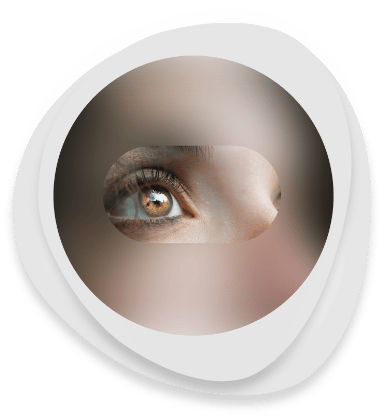February 2023
As technology has advanced, so have the options for intraocular lenses (IOLs); the artificial lens implants used to replace the eye’s natural lens during cataract surgery. With such a wide variety of IOL types now available – from traditional single-focus monofocal lenses to the latest in multifocal and accommodating lenses – it can be difficult for a pre-surgical patient (like you) to know which is best for them. This comprehensive look will take you through each type of IOL currently available so that you can gain a clear understanding of what to expect with each type.
Why Is IOL Insertion Necessary in Cataract Patients?
The role of your eye’s natural lens is to refract or bend light that enters your eye, to focus it on the retina at the back of your eye [1]. This is what gives you clear vision. However, as you age, the proteins in your natural lens begin to break down and clump together, causing your lens to become increasingly opaque or cloudy. This condition is called a cataract [2]. As the cataract progresses, it causes symptoms like fuzzy or blurry vision, faded colors, intolerance of bright lights, and sometimes double vision, glare or halos around lights [3]. During cataract surgery, this natural lens is removed and is replaced with an intraocular lens (IOL).
If you were to have cataract surgery without the implantation of an IOL, you would then be diagnosed with aphakia. Aphakia occurs when the natural lens is removed but not replaced and can cause a number of serious complications, most notably severe farsightedness, blurry vision, increased sensitivity to light, changes in color vision, and trouble focusing altogether [4]. You may need an extremely high prescription as a result, leading to very thick and heavy prescription eyeglasses which can be difficult to tolerate. This is why IOL implantation has become a standard part of cataract surgery.
How Do IOLs Work & What Materials Are They Made From?
An IOL is a small, clear disc that is inserted in the same spot as your natural lens during cataract surgery. Intraocular lenses are made from a variety of different materials, depending on the type of IOL. The most common types of IOLs are made from either silicone or acrylic, but there are also IOLs made from other materials like collamer and polymethylmethacrylate (PMMA).
IOLs work by bending the light that enters your eye in the same way that your natural lens did, to focus it on the retina. This provides you with clear vision after surgery. The type of IOL that you receive will depend on a number of factors, including the type of focusing power you need, the health of your eye, and your lifestyle preferences.
6 Types of Intraocular Lenses (IOLs)
1. Monofocal.
The monofocal IOL is one of the most commonly used types of lenses in cataract surgery. Unlike the normal, naturally occurring lens in the eye, which has an adjustable focusing power, the monofocal IOL has a fixed focal length and works by focusing light onto a single point at the back of the eye. This means that your vision can be adjusted to see only one focal length, either up-close or for distance. Most patients who choose monofocal lenses opt for distance vision, as it requires less post-operative care. However, this means that these patients must use reading glasses for up-close activities like reading, or mid-distance such as working on the computer.
Ideal candidate: all patients without complex vision problems are good candidates for monofocals, as these provide some of the sharpest vision with minimal side effects.
Common Monofocal Lens Names: Aurium, Acrysof IQ/SP, Tecnis Eyhance, and Rayner RayOne.
2. Multifocal.
The multifocal IOL provides patients with multiple focusing points, providing distance, intermediate and near vision in the eye. These lenses work by having special zones set up with different focusing powers. When the light enters your eye, it is split into these special zones, which is what allows you to see clearly at multiple distances. Due to the good range of distance vision that multifocal lenses have, many patients do not require postoperative glasses. However, if you’re doing very fine or detailed work that is extremely up-close, you may still need reading glasses. Multifocal IOLs can also correct most astigmatism. Multifocal IOLs can cause some patients to see rings around lights at night, but patients say this does not affect their ability to drive at night and is a worthwhile tradeoff for not needing glasses.
Ideal candidate: recommended for individuals who want the ability to see at all distances without glasses. Not for patients who have ocular diseases that compromise visual acuity, such as advanced macular degeneration, glaucoma, or corneal dystrophies.
Common Multifocal Lens Names: Alcon PanOptix (trifocal), Clareon® PanOptix® IOL, Acrysof IQ ReSTOR, Zeiss Trifocal, iDiff Plus, Tridiff, Tecnis Multifocal.
3. Extended Depth of Focus.
The extended depth of focus IOL type is a fairly new technology that works by bringing light to a broad focal point instead of to a small tight focal point. It provides patients with a functional range of vision, by using a series of near-sighted and far-sighted focal points that work together to increase the available depth of focus. When someone is using an EDOF lens, their vision sharpness is enhanced at intermediate, far, and near distances. What this means for the patient is that they will have a wider range of clear vision, with excellent intermediate to distance vision. A few patients will be able to read some print with an EDOF lens but most still require reading glasses. EDOF lenses can lead to nighttime halos in some patients.
Ideal candidate: this is recommended for individuals with presbyopia who want to have good distance and computer vision while reducing but not eliminating their dependence on reading glasses. It can help those with astigmatism, and it may work well for those who want to reduce swapping between different pairs of prescription eyeglasses or contact lenses.
Common EDOF Lens Names: Tecnis Symfony, Acrysof IQ Vivity.
4. Toric.
The toric IOL is a type of intraocular lens that is designed to correct astigmatism. Unlike a traditional IOL, which only corrects spherical errors (myopia or hyperopia, aka nearsightedness or farsightedness), a toric IOL corrects both spherical and astigmatic errors. The degree of correction can be customized to the patient’s individual needs to ensure clear and stable vision.
Ideal candidate: Toric IOLs are ideal for patients who have astigmatism who want to correct their vision at all distances. If astigmatism is not corrected by an IOL it will need to be corrected with glasses or toric contact lenses. Each of these have drawbacks. Astigmatism correction in glasses can cause “prismatic effects” where light in the periphery is bent and warped like a fun-house mirror. Toric contact lenses can rotate, causing blurred vision and can be uncomfortable to wear. A toric IOL eliminates the need for glasses or contact lenses to correct the astigmatism.
Common Toric Lens Names: Tecnis Eyhance Toric II, Acrysof IQ, Zeiss Toric, Tecnis Synergy Toric.
5. Light Adjustable Lenses.
A light adjustable lens, or LAL, is a type of IOL that is made from a photosensitive material that can be adjusted after surgery to improve vision. The photosensitive material that LAL’s are made from changes shape when exposed to certain types of UV light. This allows the surgeon to fine-tune the focus of the lens after surgery, using a painless adjustment process with beams of light. This process is usually done in two or three sessions, and each session lasts about 15 minutes, and alters the shape of the LAL, thus changing how the light is bent and processed by your eye. As a result, the LAL can be used to correct a wide range of vision problems, including nearsightedness, farsightedness, and astigmatism. Think of a large rectangular block of ice that is fashioned by an artist into a beautiful ice sculpture. The LAL is like this, it can be molded and sculpted (with painless beams of light) into the exact shape of lens needed for that unique eye. No two are exactly the same, truly personalized vision.
Ideal candidate: LALs are an excellent option for patients who might have difficulty achieving clear vision with traditional IOLs. The ideal candidate for a LAL is someone who is willing to put in a little work (return for follow-up appointments) for a truly customized outcome with exceptionally clear vision, often without any glasses. LALs are especially superb for patients who previously had LASIK or other corneal surgeries.
Common LAL Lens Names: RxSight
6. Small Aperture IOL.
This IOL is also known as the Apthera, IC-8 or “pinhole” lens. It is unique in that it is only used in one eye. We all have a favored or dominant eye. The other eye is the non-dominant eye. The small aperture IOL is implanted in the non-dominant eye. This IOL has a unique “filter ring” coating. This black ring allows light to enter through the center but blocks peripheral defocused or aberrated light. The result is clear distance, intermediate and near vision without glasses. It also corrects for up to 1.5 diopters of astigmatism. If you have ever looked through a small hole (aka pinhole) at your eye doctor’s clinic and were astounded that it made you see more clearly, this is the same concept.
Ideal candidate: Pinhole/IC-8/Apthera IOLs are best for patients who want to have very good distance vision day and night without halos and want to improve their intermediate/near vision. Extremely small print or reading in dim environments may still require over the counter reading glasses. These lenses may also be a good choice for patients with very abnormal corneas following RK, corneal scarring, corneal transplantation, or keratoconus as it blocks distorted light but allows clear central pupillary light to pass through.
With so many types of intraocular lenses (IOLs) available to patients who want to improve their vision, a wide range of vision problems can be corrected including nearsightedness, farsightedness, and astigmatism. To find out which type of IOL is best for your vision needs and lifestyle preferences, contact us today for a consultation, and we’ll get you on track to improving your vision.








